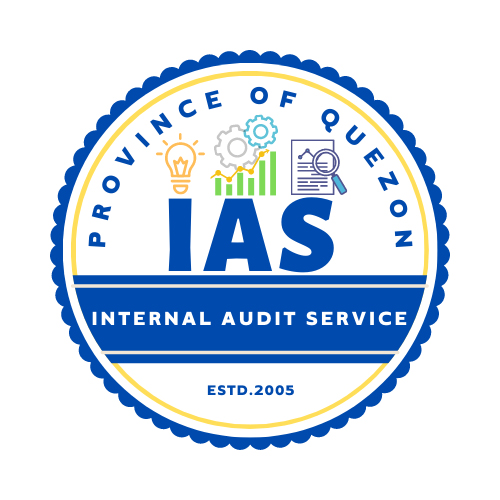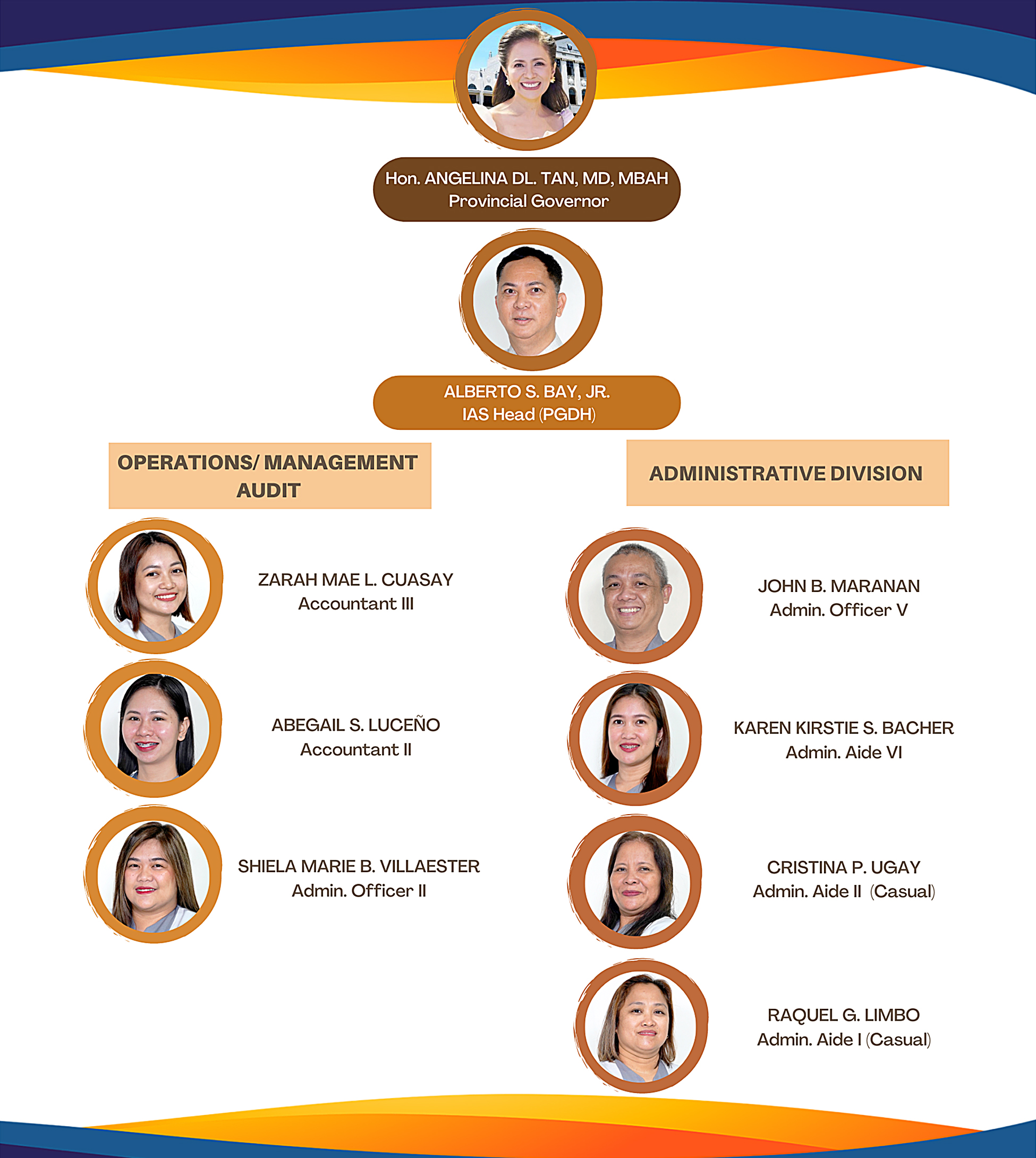PROVINCIAL INTERNAL AUDIT SERVICE OFFICE

Mission
To provide efficient and excellent legal service to the Provincial Government of Quezon and its component municipalities, always in furtherance of the interest of the people of Quezon. To uplift the condition of life of its constituents by taking a proactive role in formulating measures to carry out delivery of basic services and provisions of adequate facilities. To initiate legal advocacies to promote and defend human rights.
Vision
A competent, objective and independent organization providing management with quality and well prepared assessments of government operations for a more effective, efficient and transparent Provincial Government of Quezon.
MANDATE
Under Sangguniang Panlalawigan Resolution No. 2005-440 dated June 27, 2005 approving the creation of Internal Audit Service in the Provincial Government of Quezon pursuant to Administrative Order No. 278 dated April 28, 1992 and reiterated in Administrative Order No. 70 dated April 14, 2003
FUNCTIONS OF INTERNAL AUDIT SERVICE
- Advise the Head of Agency on all matters relating to management control and operations audits;
- Conduct management and operations audits of Department/ Agency;
- Review and appraise systems and procedures;
- Analyze and evaluate management deficiencies; and
- Perform such other related duties and responsibilities as may be assigned or delegated by the Head of Agency or as may be required by law.

THREE (3) DIVISIONS OF THE IAS OFFICE
I. OPERATIONS AUDIT DIVISION
The Operations Audit Division shall evaluate the extent of compliance and ascertain the effective, efficient, ethical, and economical execution of operations by utilizing internal auditing methods. The Division is tasked to perform the following functions:
- Conduct operations audit of activities of the LGU and its departments and determine the degree of compliance with the mandate, policies, government regulations, established objectives, systems and procedures/processes, and contractual obligations (Section 2.4b, DBM Circular Letter No. 2008-5);
- Review and appraise systems and procedures/processes, organizational structure, operations practices, operations records, reports, and performance standards of the LGU and the departments covered (Section 2.4c, DBM Circular Letter No. 2008-5);
- Verify and analyze operations data to ascertain if attendant management information systems generate data or reports that are complete, accurate, and valid (Section 4.1.1.2, DBM Budget Circular No. 2004-4);
- Ascertain the reliability and integrity of operational information and the means used to identify, measure, classify, and report such information (Section 1.1.1, AO No. 278 s. 1992);
- Review operations or programs to ascertain whether or not results are consistent with established objectives and goals, and whether or not such programs are being carried out as planned (Section 1.1.5, AO 278 s.1992); f. Evaluate the quality of performance of groups/individuals in carrying out their assigned responsibilities (Section 1.1.6, AO 278 s. 1992);
- Recommend courses of action on operational deficiencies observed (Section 1.1.7, AO 278 s. 1992);
- Perform functions of a protective nature, such as prevention and detection of fraud or dishonesty; review of cases involving misuse of agency property; and checking of transactions with outside parties (Section 4.1.1.4, DBM Budget Circular No. 2004-4); and
- Perform miscellaneous services, including special investigations and assistance to outside contacts such as COA (Section 4.1.1.5, DBM Budget Circular No. 2004-4).
II. MANAGEMENT AUDIT DIVISION
The Management Audit Division shall evaluate the achievement of the control objectives, which include the safeguarding of assets, checking the accuracy and reliability of accounting data, adherence to managerial policies, compliance with laws, rules, and regulations by utilizing internal auditing methods. It has the following functions:
- Conduct management audit of activities of the LGU and determine the degree of compliance with the mandate, policies, government regulations, established objectives, systems and procedures/ processes, and contractual obligations (Section 2.4b, DBM Circular Letter No. 2008-5 and Section 1.1.2, AO 278, s. 1992);
- Review and appraise systems and procedures/processes, organizational structure, assets management practices, financial and management records, reports, and performance standards of the LGUs covered (Section 2.4c, DBM Circular Letter No. 2008-5);
- Verification and analysis of financial and management data to ascertain if attendant management information systems generate data or reports that are complete, accurate, and valid (Section 4.1.1.2, DBM Budget Circular No. 2004-4);
- Ascertain the reliability and integrity of financial and management information and the means used to identify, measure, classify, and report such information (Section 1.1.1, AO No. 278, s. 1992);
- Ascertain the extent to which the assets and other resources of the institutions are accounted for and safeguarded from losses of all kinds (Section 1.1.3, AO 278, s. 1992);
- Review and evaluate the soundness, adequacy and application of accounting, financial and management controls and promote the most effective control at reasonable cost (Section 1.1.4, AO 278, s. 1992);
- Evaluate the quality of performance of groups/individuals in carrying out their assigned responsibilities (Section 1.1.6, AO 278, s. 1992);
- Perform functions of a protective nature, such as prevention and detection of fraud or dishonesty; review of cases involving misuse of agency property; and checking of transactions with outside parties (4.1.1.4, DBM Budget Circular No. 2004-4); and
- Perform miscellaneous services, including special investigations and assistance to outside contacts such as COA (Section 4.1.1.5, DBM Budget Circular No. 2004-4)
III. ADMINISTRATIVE DIVISION
The administrative division manages all daily operations of IAS. This includes strategic planning, budgeting, legal affairs, and HR management. It monitors performance and makes decisions for future improvements, ensuring efficient services related to personnel, records, correspondence, supplies, equipment, security, and reporting to other agencies. The division is tasked with the following functions:
- Oversee, integrate, and coordinate the activities of the IAS, including assisting in directing and administering the activities of divisions;
- Establish and execute the necessary administrative systems within the IAS office, including recruitment and selection, performance appraisal, personnel action and records, benefits administration, supplies and equipment procurement, recording and disposal, office maintenance, and reporting, in collaboration with relevant offices to enhance work efficiency and effectiveness;
- Develop and administer personnel program including among others training, employee career and development, performance evaluation, employee relations and welfare, promotions, transfers, attendance, leave of absence and other personnel transactions;
- Ensure that personnel management and development plans and policies are implemented, offer administrative support and guidance to the office head in assessing performance appraisals of all IAS staff, and collaborate with HRMO to establish a reward and recognition system. Furthermore, effectively plan, oversee, and utilize all IAS personnel within the framework of existing rules, and provide recommendations for necessary administrative and disciplinary actions when required;
- Manage IAS records and office assets while offering cost-effective, efficient services for personnel, records, supplies, equipment, maintenance, security, and custodial work, including developing and upholding the records management system;
- Coordinate office functions and activities and maintain linkages between and among offices, government agencies and other institutions relative to its areas of concern;
- Prepare and submit reports required by other offices and agencies concerned; and
- Perform such other related functions as may be provided by law.

